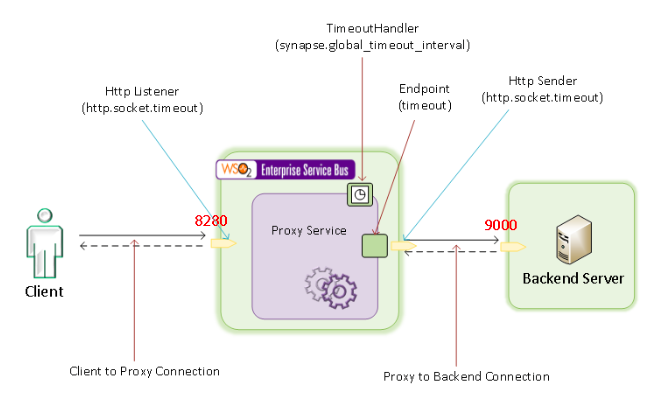Best practices for working with endpoints¶
-
Do not use anonymous endpoints. Always use named endpoints. As anynymous endpoints have auto-generated names in the synapse configuration, it is difficult to identify which endpoint is causing the error in case of an error.
-
Configure timeout settings appropriately. Timeout configurations are required before you go into production with the system.
The diagram below illustrates the typical message flow when a proxy
service is involved in a client-server communication. The two
connectores, Client to Proxy connection and
Proxy to Backend connection are two
separate connections that do not depend on each other. Even if one
connections times out, the other is unaffected.
Here are the important timeout parameters you should configure before going into production:
| Parameter | Description | Configuration File | Default Value | Recommended Value |
|---|---|---|---|---|
[transport.http]
socket_timeout = 180000 |
The socket timeout of the Passthrough http/https transport sender and listener. You can find the passthru-http.properties file in the <EI_HOME>/conf directory. |
deployment.toml |
180000 | 180000 |
| Endpoint timeout | The timeout parameter that you should configure at the endpoint level. You can configure timeout values as required for specific endpoints. Here's a sample endpoint configuration that is configured with timeout parameters. Here, Follow the formula |
Endpoint configuration files | synapse.global_timeout_interval | Depends on the use case, Typically 120000 |
[mediation]
synapse.global_timeout_interval = "120000" |
Global timeout value for endpoints. Can be overwritten by individual endpoint timeout values. Synapse, which is the underlying mediation engine of ESB Micro Integrator, is a complete asynchronous messaging engine that does not block its worker threads on network I/O. Instead, it registers a call-back for a particular request and returns the threads without waiting for a response. When a response is available, the registered call-back is used to correlate it with the relevant request so that further processing can be done. If you have configured a timeout value at the endpoint level, the global timeout value is not taken into consideration for that endpoint. For all the other endpoints that do not have a timeout value configured, the global value is considered as the timeout value. You can configure the |
deployment.toml |
120000 | 120000 |
[synapse_properties]
synapse.timeout_handler_interval = "15000"
|
Duration between two TimeoutHandler executions.The TimeoutHandler is executed every 15 seconds by default. Therefore, the time that call-backs get cleared can deviate up to 15 seconds from the configured value.You can configure the TimeoutHandler execution interval by specifying a required value for synapse.timeout_handler_interval in the <MI_HOME>/conf/deployment.toml file. |
deployment.toml |
15000 | 15000 |
-
Set the socket timeout value and individual endpoint timeout values appropriately. Use this formula to set timeout values:
Socket Timeout > max(Global endpoint timeout Timeout of individual endpoints) -
Be sure to set proper values to advanced configuration parameters, although they are optional.
The happy path should work with the default values, but you might encounter issues in production when the system does not follow the happy path. For example, if you use the default configurations and as an error occurs in your sequence, the endpoint gets suspended immediately and subsequent messages to that endpoint get rejected without being sent to the backend service. This might not be the expected behaviour in every use case. Therefore, it is important to perform endpoint error handling based on the use case. -
Use the HTTP endpoint for RESTful service invocations. The HTTP endpoint is especially designed to make RESTful service integration easy. For example, it supports
url-templates, which is an option to set the http method. -
For RESTful service integration, use either REST APIs or HTTP endpoints. You can use REST APIs to expose an integration solution as a RESTful service, and use HTTP endpoints to logically represent a RESTful backend service.
